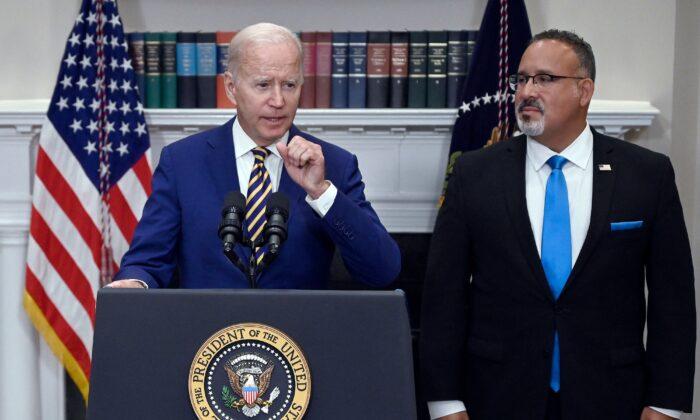President Joe Biden’s proposed income-based student loan repayment plan could cost $475 billion over a period of 10 years and end up encouraging “more loan borrowing” among college students, according to the University of Pennsylvania.
Mr. Biden’s “Saving on A Valuable Education” (SAVE) scheme aims to reduce the income-based monthly payments on student loans by half, remove monthly payments for individuals earning minimum wage, and forgive all outstanding debt on student loans once the borrower pays for 10 years, provided the loan amount is $12,000 or less.
According to an estimate by the Department of Education, the SAVE plan will cost $138 billion over a decade.
However, the University of Pennsylvania’s Penn Wharton’s Budget Model predicts the cost to be higher by more than three times. “We estimate SAVE will incur a net cost of $475 billion over the 10-year budget window,” a July 17 post about the Budget Model said.
Roughly $200 billion of this cost will come from payment reduction for the student loans that are already outstanding this year. Once SAVE comes into effect in July next year, the model estimates that over half of the current loan volume will switch to the plan.
The remaining $275 billion of the cost will come from reduced payments for around $1 trillion in new loans that the model calculates will be extended over the next decade.
The model warns that “due to the increased generosity of the newly proposed IDR (income-driven repayment) plan, future student borrowers have the incentive to increase their federal student loan borrowing.” As a result, the current college financing pattern will shift toward “more loan borrowing instead of paying out-of-pocket.”
The SAVE Plan
The SAVE plan was announced last year. However, it was overshadowed by another plan from the Biden administration that aimed to forgive almost 40 million student-loan borrowers at a cost of $800 billion.But after the U.S. Supreme Court struck down the $800 billion plan, the White House once more turned its attention to SAVE. The Education Department is pushing the scheme as the “most affordable payment plan ever.”

“The SAVE Plan calculates your monthly payment amount based on your income and family size. Starting this summer, if you’re making $32,800 a year or less (which is roughly $15 an hour), your monthly payment will be $0. If you’re making more than that, you will save at least $1,000 a year, compared to other IDR plans,” according to the plan.
Beginning next summer, borrowers on the SAVE plan who have taken undergraduate loans could see their repayments cut down from 10 percent to 5 percent of income.
Negative Consequences
Experts have raised concerns about the negative consequences that Mr. Biden’s SAVE plan can have on America. In an interview with The Epoch Times, Caleb Kruckenberg, an attorney at Pacific Legal Foundation, warned that taxpayers will be on the hook for a “gigantic government handout” when people are struggling with inflation.SAVE will also worsen tuition inflation as it sends a message that colleges can keep on raising the cost of higher education while taking benefit of such federal programs, he said.
“Because every college knows that if there’s more funding, more free money, the best way to take advantage of that is to raise tuition for everybody.”
Many small-business owners also do not agree with the president’s push to forgive or cancel student debt. Over 70 percent of entrepreneurs in a June survey by the Job Creators Network Foundation (JCNF) opposed such plans.
In a June 30 statement, Alfredo Ortiz, president and CEO of Job Creators Network, slammed President Biden for commenting against the Supreme Court order striking down the student loan forgiveness plan.
“President Biden shamelessly failed to recognize a co-equal branch of government in his remarks,” Mr. Ortiz said. “Rather than respecting the court’s decision, Biden promised more executive overreach to forgive student loan debt. His proposals include expanded income-driven repayment plans and a 12-month grace period when payments are set to restart this fall.”
“Job Creators Network Foundation is weighing its legal options to fight these bailout workarounds when they are finalized,” he added.
When asked by reporters if Mr. Biden’s student loan program will cost taxpayers $558 billion more than estimated, House Speaker Kevin McCarthy (R-Calif.) said, “He [Mr. Biden] is trying to make about 77 percent of America to pay for about 10 percent of America. I don’t think that’s right.
“You take out a loan; you say you’re going to pay it back; in America, you pay your loan back.”





